Decreasing Electrical Resistivity of Ag Film by Low-Temperature Evaporation and Sintering through Azeotrope Application
Abstract
1. Introduction
2. Materials and Methods
2.1. Ingredients for Paste
2.2. Paste Preparation and Sintering
2.3. Characterization
3. Results and Discussion
4. Conclusions
Author Contributions
Funding
Data Availability Statement
Conflicts of Interest
References
- Gao, L.; Chao, L.; Hou, M.; Liang, J.; Chen, Y.; Yu, H.; Huang, W. Flexible, transparent nanocellulose paper-based perovskite solar cells. npj Flex. Electron. 2019, 3, 1–8. [Google Scholar] [CrossRef]
- Lee, K.-T.; Jang, J.-Y.; Park, S.J.; Ok, S.A.; Park, H.J. Incident-angle-controlled semitransparent colored perovskite solar cells with improved efficiency exploiting a multilayer dielectric mirror. Nanoscale 2017, 9, 13983–13989. [Google Scholar] [CrossRef] [PubMed]
- Cui, D.; Yang, Z.; Yang, D.; Ren, X.; Liu, Y.; Wei, Q.; Fan, H.; Zeng, J.; Liu, S. Color-tuned perovskite films prepared for efficient solar cell applications. J. Phys. Chem. C 2016, 120, 42–47. [Google Scholar] [CrossRef]
- Schlisske, S.; Mathies, F.; Busko, D.; Strobel, N.; Rödlmeier, T.; Richards, B.; Lemmer, U.; Paetzold, U.; Hernández-Sosa, G.; Klampaftis, E. Design and color flexibility for inkjet-printed perovskite photovoltaics. ACS Appl. Energy Mater. 2019, 2, 764–769. [Google Scholar] [CrossRef]
- Quiroz, C.O.R.; Bronnbauer, C.; Levchuk, I.; Hou, Y.; Brabec, C.J.; Forberich, K. Coloring semitransparent perovskite solar cells via dielectric mirrors. ACS Nano 2016, 10, 5104–5112. [Google Scholar] [CrossRef]
- Bati, A.S.R.; Zhong, Y.L.; Burn, P.L.; Nazeeruddin, M.K.; Shaw, P.E.; Batmunkh, M. Next-generation applications for integrated perovskite solar cells. Commun. Mater. 2023, 4, 2. [Google Scholar] [CrossRef]
- Bing, J.; Granados Caro, L.; Talathi, H.P.; Chang, N.L.; Mckenzie, D.R.; Ho-Baillie, A.W.Y. Perovskite solar cells for building integrated photovoltaics—Glazing applications. Joule 2022, 6, 1446–1474. [Google Scholar] [CrossRef]
- Zhu, Y.; Shu, L.; Fan, Z. Recent Progress on Semi-transparent Perovskite Solar Cell for Building-integrated Photovoltaics. Chem. Res. Chin. Univ. 2020, 36, 366–376. [Google Scholar] [CrossRef]
- Koh, T.M.; Wang, H.; Ng, Y.F.; Bruno, A.; Mhaisalkar, S.; Mathews, N. Halide Perovskite Solar Cells for Building Integrated Photovoltaics: Transforming Building Façades into Power Generators. Adv. Mater. 2022, 34, 2104661. [Google Scholar] [CrossRef]
- Wang, H.; Li, J.; Dewi, H.A.; Mathews, N.; Mhaisalkar, S.; Bruno, A. Colorful Perovskite Solar Cells: Progress, Strategies, and Potentials. J. Phys. Chem. Lett. 2021, 12, 1321–1329. [Google Scholar] [CrossRef]
- Mujahid, M.; Chen, C.; Zhang, J.; Li, C.; Duan, Y. Recent advances in semitransparent perovskite solar cells. InfoMat 2021, 3, 101–124. [Google Scholar] [CrossRef]
- Nazir, G.; Lee, S.-Y.; Lee, J.-H.; Rehman, A.; Lee, J.-K.; Seok, S.I.; Park, S.-J. Stabilization of Perovskite Solar Cells: Recent Developments and Future Perspectives. Adv. Mater. 2022, 34, 2204380. [Google Scholar] [CrossRef] [PubMed]
- Rakocevic, L.; Gehlhaar, R.; Jaysankar, M.; Song, W.; Aernouts, T.; Fledderus, H.; Poortmans, J. Translucent, color-neutral and efficient perovskite thin film solar modules. J. Mater. Chem. C 2018, 6, 3034–3041. [Google Scholar] [CrossRef]
- Yang, D.; Huang, Y.; Tian, Y. Microstructure of Ag nano paste joint and its influence on reliability. Crystals 2021, 11, 1537. [Google Scholar] [CrossRef]
- Yang, H. Study on the preparation process and sintering performance of doped nano-silver paste. Rev. Adv. Mater. Sci. 2022, 61, 969–976. [Google Scholar] [CrossRef]
- Ma, L.; Wang, Y.; Jia, Q.; Zhang, H.; Wang, Y.; Li, D.; Zou, G.; Guo, F. Low-temperature-sintered nano-Ag film for power electronics packaging. J. Electron. Mater. 2024, 53, 228–237. [Google Scholar] [CrossRef]
- Chen, C.; Choe, C.; Kim, D.; Zhang, Z.; Long, X.; Zhou, Z.; Wu, F.; Suganuma, K. Effect of oxygen on microstructural coarsening behaviors and mechanical properties of Ag sinter paste during high-temperature storage from macro to micro. J. Alloys Compd. 2020, 834, 155173. [Google Scholar] [CrossRef]
- Yan, J. A Review of Sintering-Bonding Technology Using Ag Nanoparticles for Electronic Packaging. Nanomaterials 2021, 11, 927. [Google Scholar] [CrossRef]
- Divitini, G.; Cacovich, S.; Matteocci, F.; Cinà, L.; Di Carlo, A.; Ducati, C. In situ observation of heat-induced degradation of perovskite solar cells. Nat. Energy 2016, 1, 15012. [Google Scholar] [CrossRef]
- Sasaki, K.; Mizumura, N. Development of Low-temperature Sintering Nano-Ag Pastes Using Lowering Modulus Technologies. In Proceedings of the IEEE 17th International Conference on Nanotechnology (IEEE-NANO), Pittsburgh, PA, USA, 25–28 July 2017. [Google Scholar]
- Jung, K.-H.; Min, K.D.; Lee, C.-J.; Park, B.-G.; Jung, H.; Koo, J.-M.; Lee, B.; Jung, S.-B. Effect of epoxy content in Ag nanoparticle paste on the bonding strength of MLCC packages. Appl. Surf. Sci. 2019, 495, 143487. [Google Scholar] [CrossRef]
- Ho, L.N.; Wu, T.F.; Nishikawa, H. Properties of Phenolic-Based Ag-Filled Conductive Adhesive Affected by Different Coupling Agents. J. Adhes. 2013, 89, 847–858. [Google Scholar] [CrossRef]
- Wu, H.; Chiang, S.; Han, W.; Tang, Y.; Kang, F.; Yang, C. Surface iodination: A simple and efficient protocol to improve the isotropically thermal conductivity of silver-epoxy pastes. Compos. Sci. Technol. 2014, 99, 109–116. [Google Scholar] [CrossRef]
- Fang, S.; Zhang, Y.; Huang, C.; Liu, P.; Zhang, C.; Liu, Y.; Li, S. Hybrid silver pastes with synergistic effect of multi-scale silver fillers and the application in flexible circuits. J. Mater. Sci. Mater. Electron. 2021, 32, 13777–13786. [Google Scholar] [CrossRef]
- Zhao, L.; Lin, Z.; Liu, Y.; Shi, Z.; Yu, L.; Li, Z. Parametric study on conductive patterns by low-temperature sintering of micron silver ink. J. Mater. Sci. Mater. Electron. 2023, 34, 653–659. [Google Scholar] [CrossRef]
- Liu, X.; Wu, S.; Chen, B.; Ma, Y.; Huang, Y.; Tang, S.; Liu, W. Tuning the electrical resistivity of conductive silver paste prepared by blending multi-morphologies and micro-nanometers silver powder. J. Mater. Sci. Mater. Electron. 2021, 32, 13777–13786. [Google Scholar] [CrossRef]
- Noh, S.; Choe, C.; Chen, C.; Zhang, H.; Suganuma, K. Printed wire interconnection using Ag sinter paste for wide band gap power semiconductors. J. Mater. Sci. Mater. Electron. 2018, 29, 15223–15232. [Google Scholar] [CrossRef]
- Zhang, H.; Nagao, S.; Suganuma, K.; Albrecht, H.-J.; Wilke, K. Thermostable Ag die-attach structure for high-temperature power devices. J. Mater. Sci. Mater. Electron. 2016, 27, 1337–1345. [Google Scholar] [CrossRef]
- Yang, F.; Hu, B.; Peng, Y.; Hang, C.; Chen, H.; Lee, C.; Wei, J.; Li, M. Ag microflake-reinforced nano-Ag paste with high mechanical reliability for high-temperature applications. J. Mater. Sci. Mater. Electron. 2019, 30, 5526–5532. [Google Scholar] [CrossRef]
- Martin, H.A.; Hu, D.; Liu, X.; Poelma, R.H.; Smits, E.C.P.; Van Driel, W.D.; Zhang, G. Prognostic Monitoring of Power QFN Packages with Silver Sintered Die-Attach Materials. IEEE Trans. Compon. Packag. Manuf. Technol. 2024. [Google Scholar] [CrossRef]
- Wang, M.; Mei, Y.-H.; Jin, J.; Chen, S.; Li, X.; Lu, G.-Q. Pressureless Sintered-Silver Die-Attach at 180 °C for Power Electronics Packaging. IEEE Trans. Power Electron. 2021, 36, 12141–12145. [Google Scholar] [CrossRef]
- Yao, S.; Xing, J.; Zhang, J.; Xiong, S.; Yang, Y.; Yuan, X.; Li, H.; Tong, H. Microscopic investigation on sintering mechanism of electronic silver paste and its effect on electrical conductivity of sintered electrodes. J. Mater. Sci. Mater. Electron. 2018, 29, 18540–18546. [Google Scholar] [CrossRef]
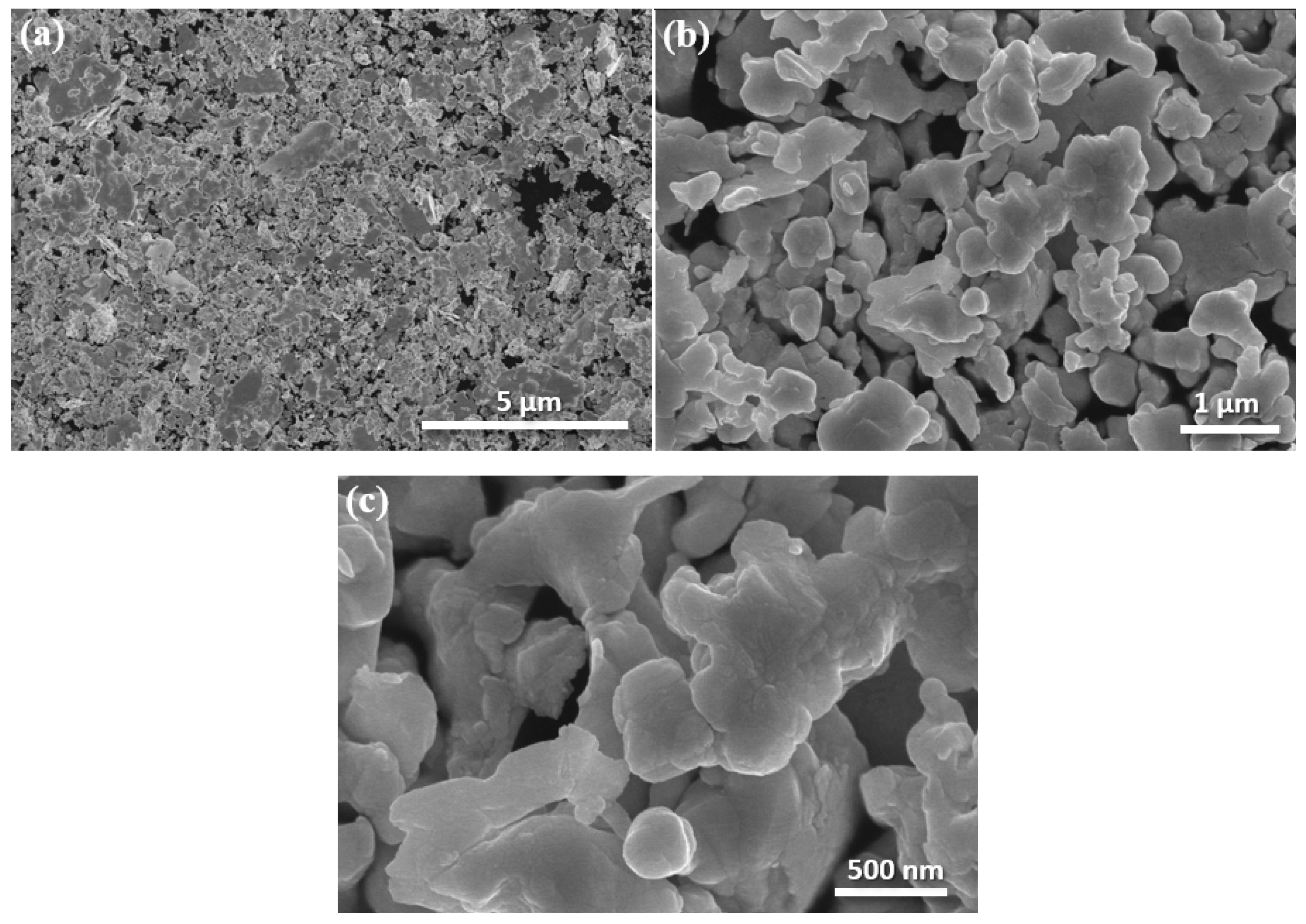
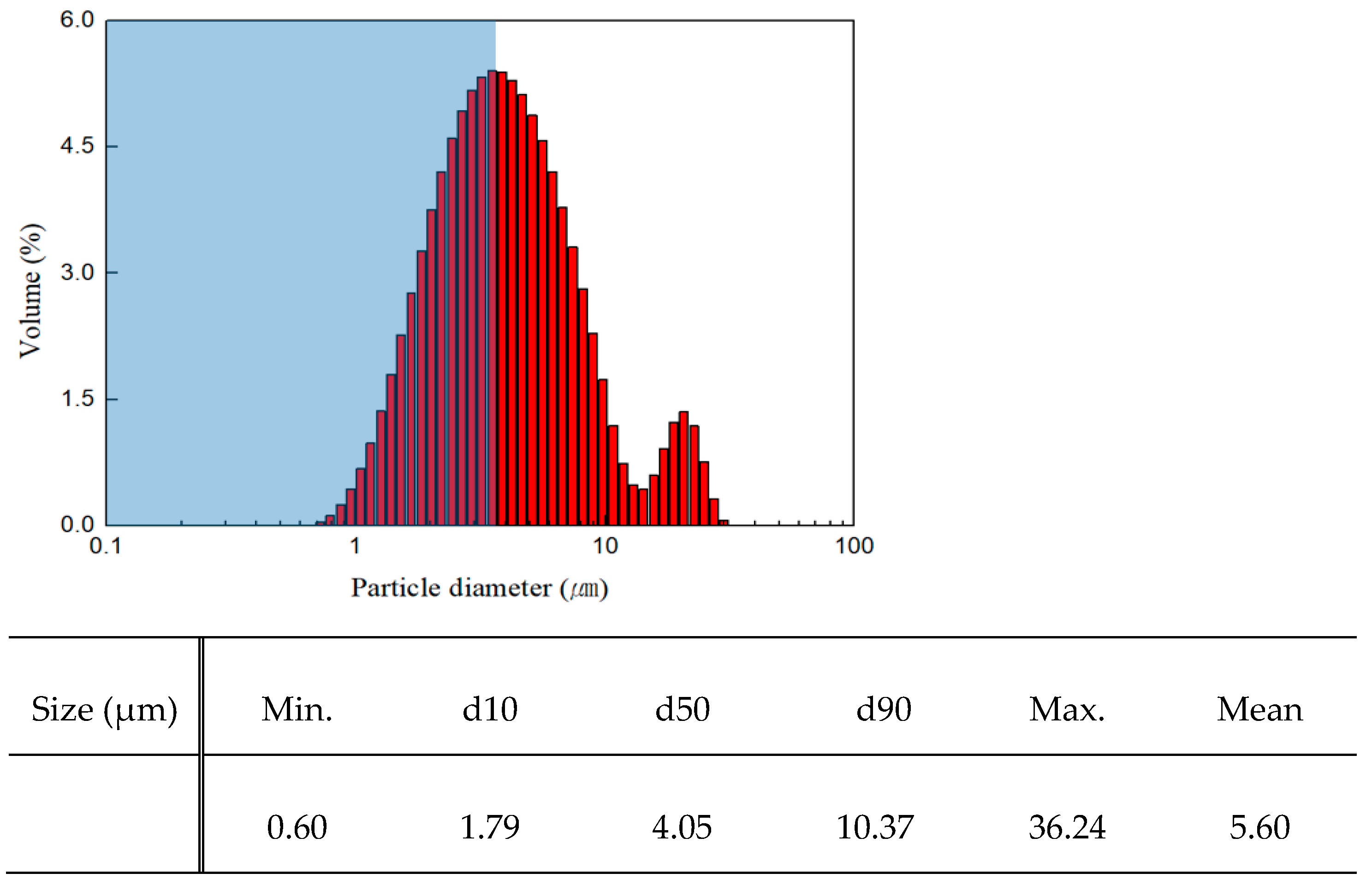
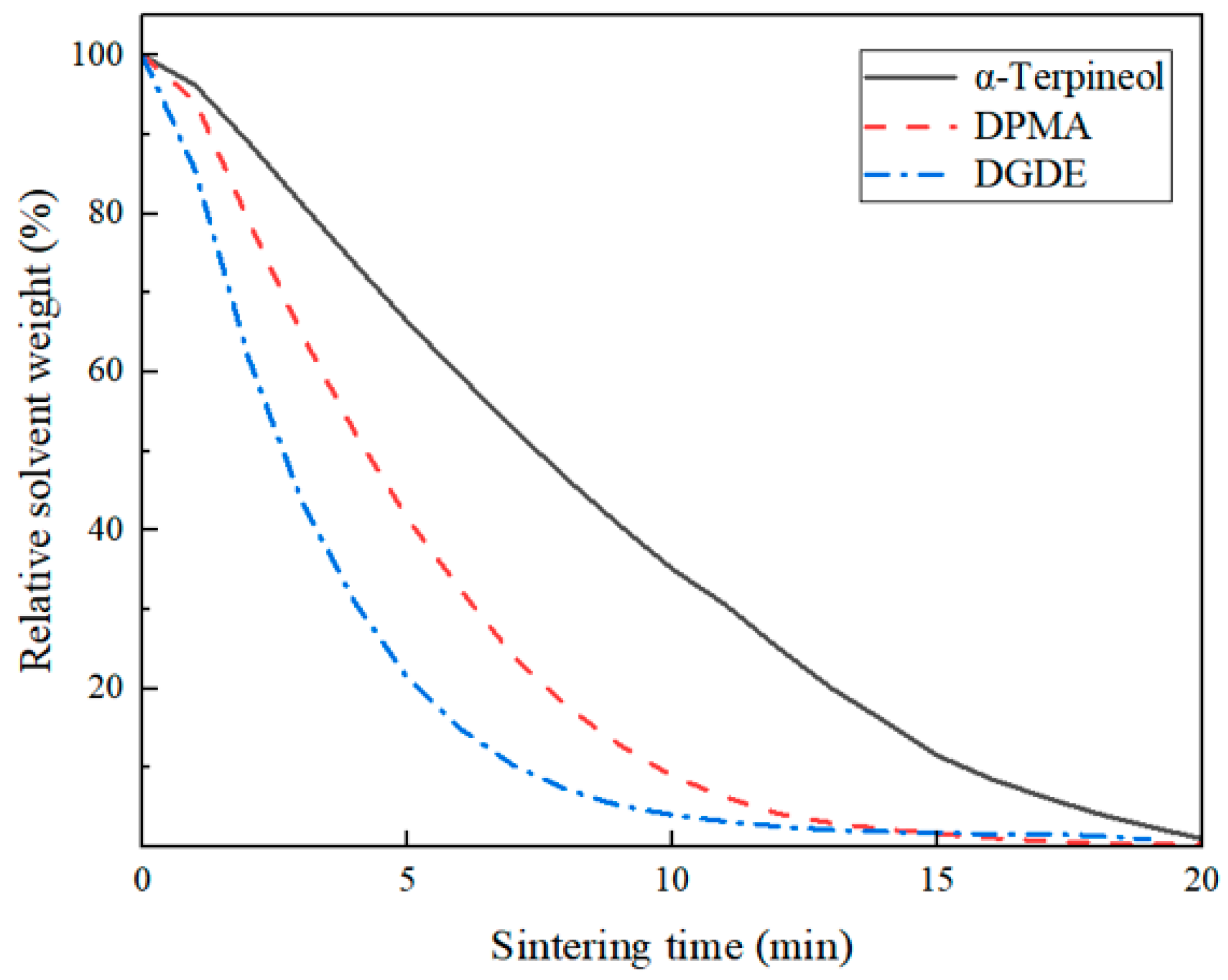

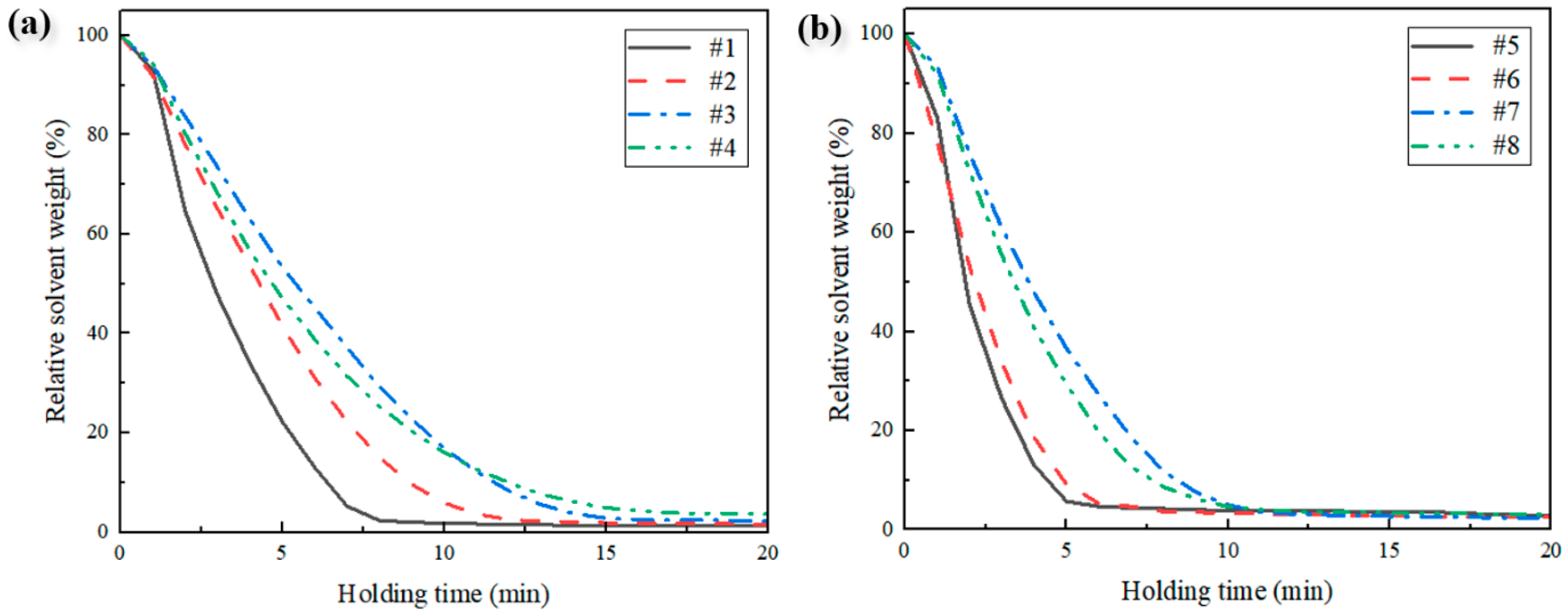
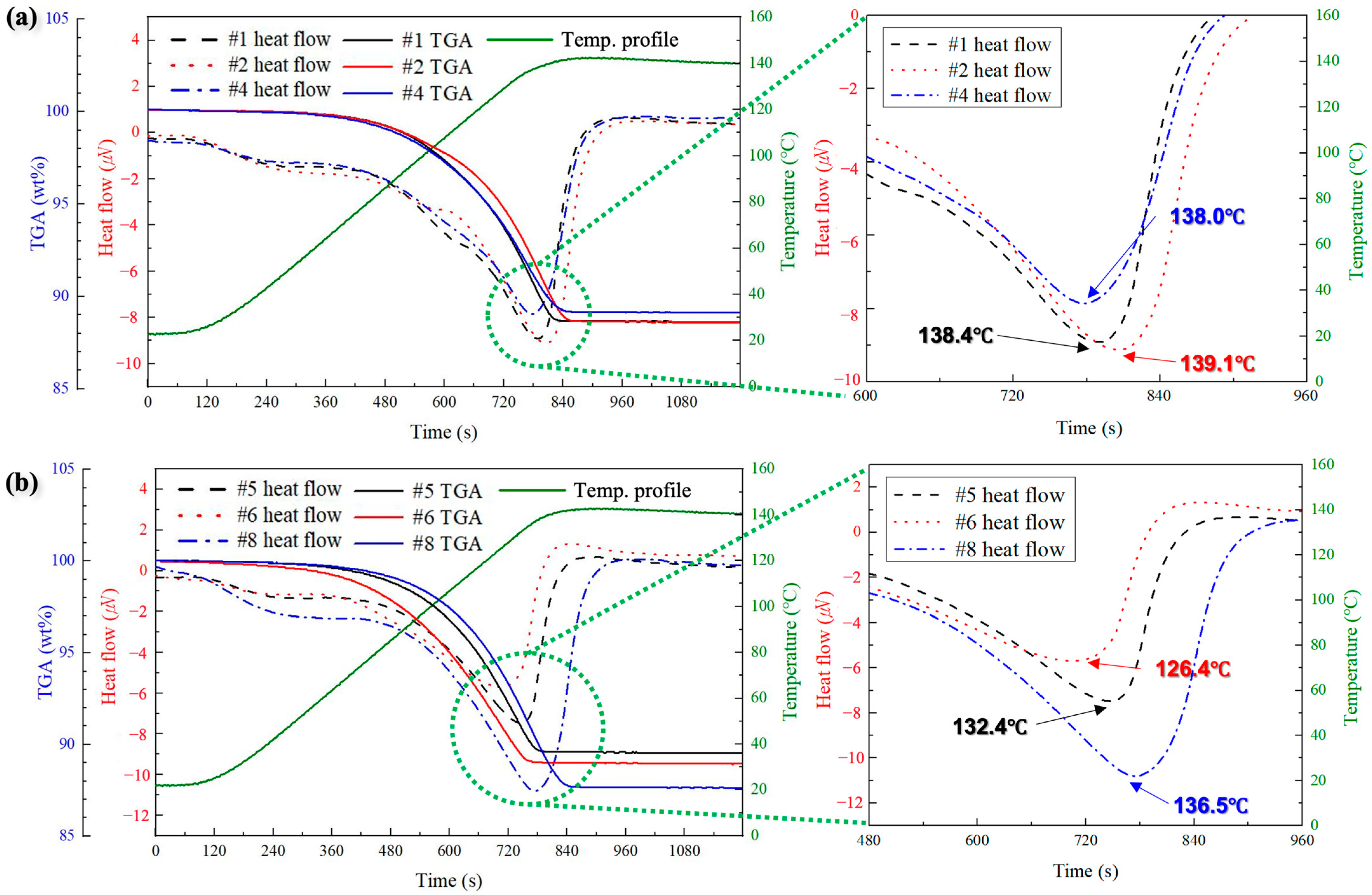

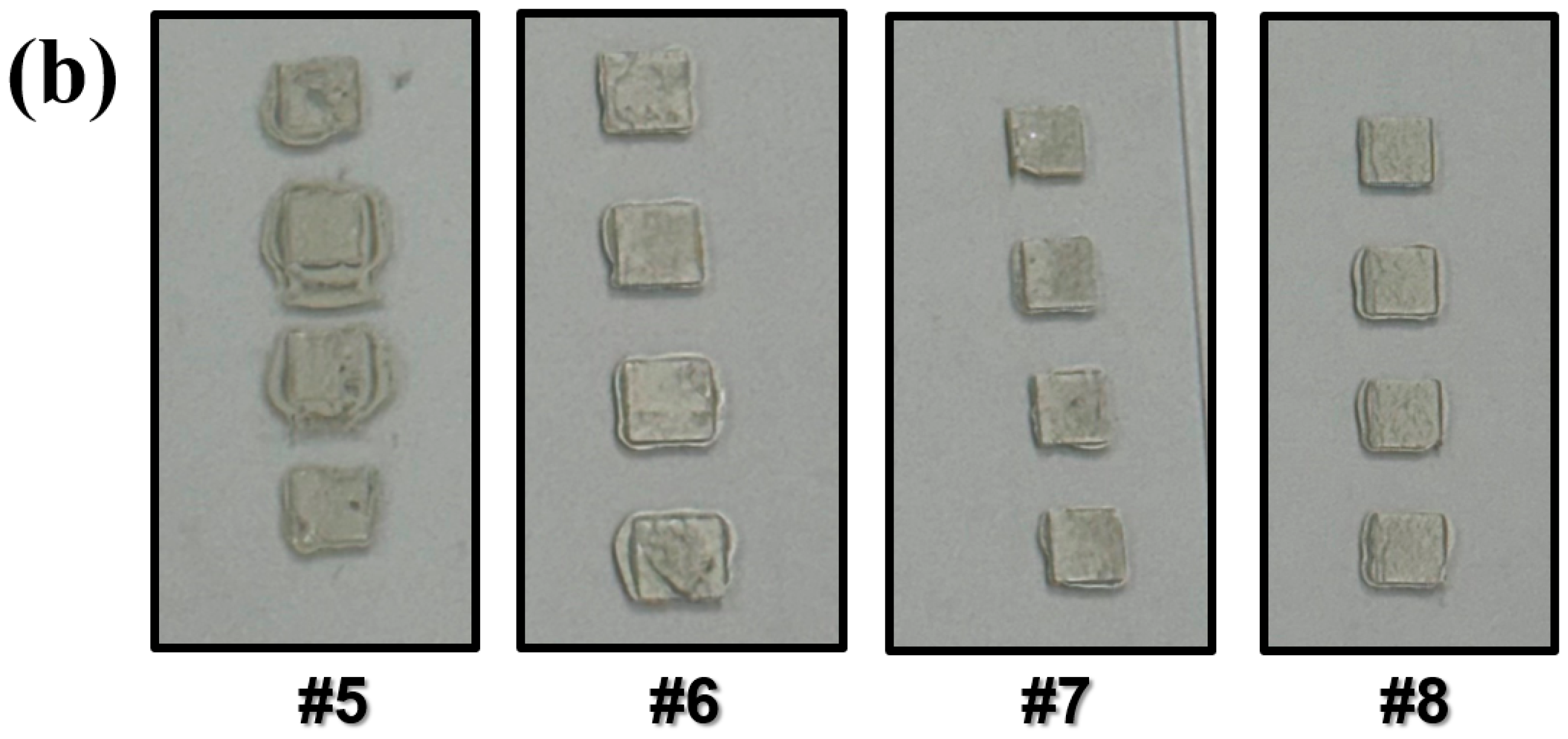

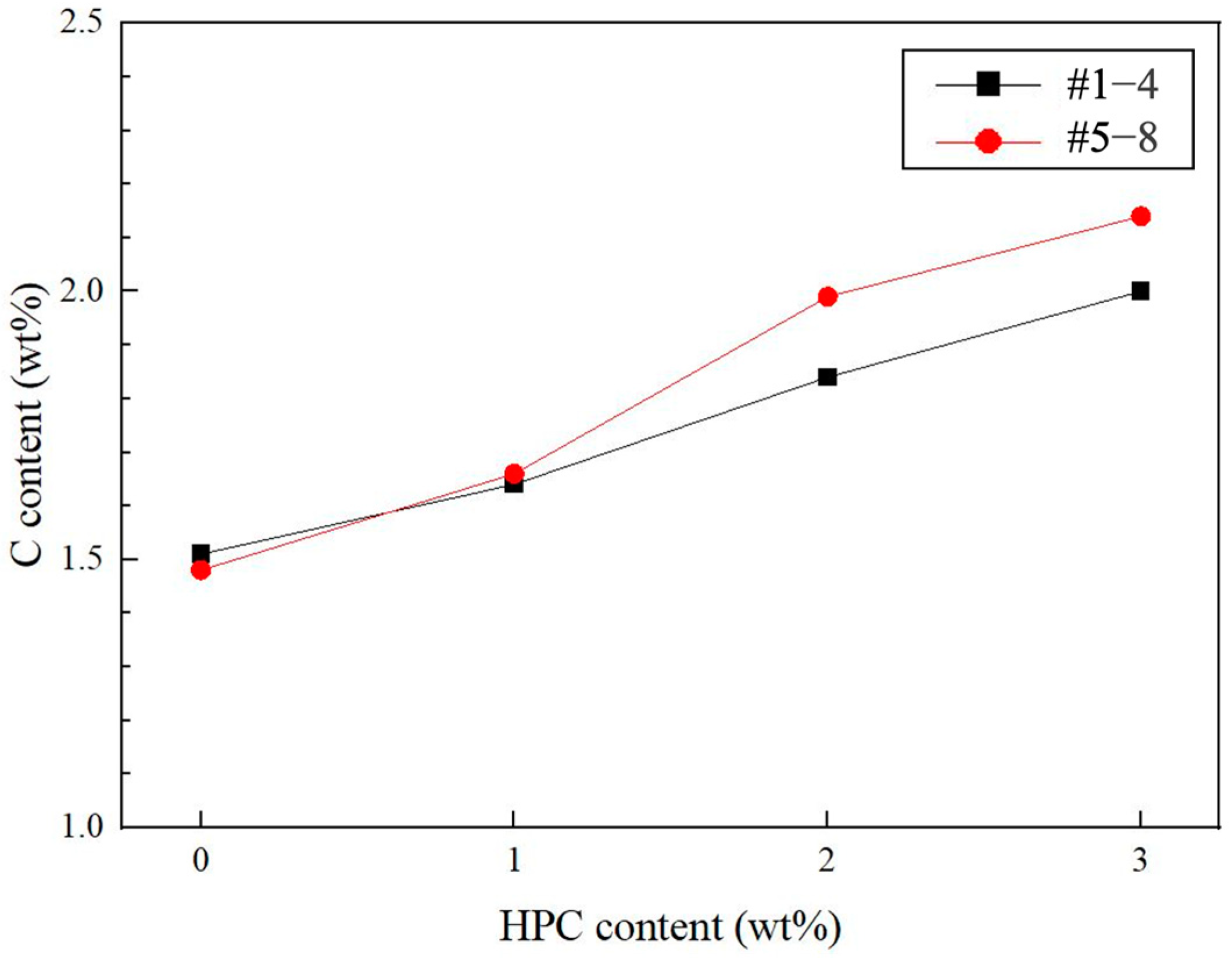
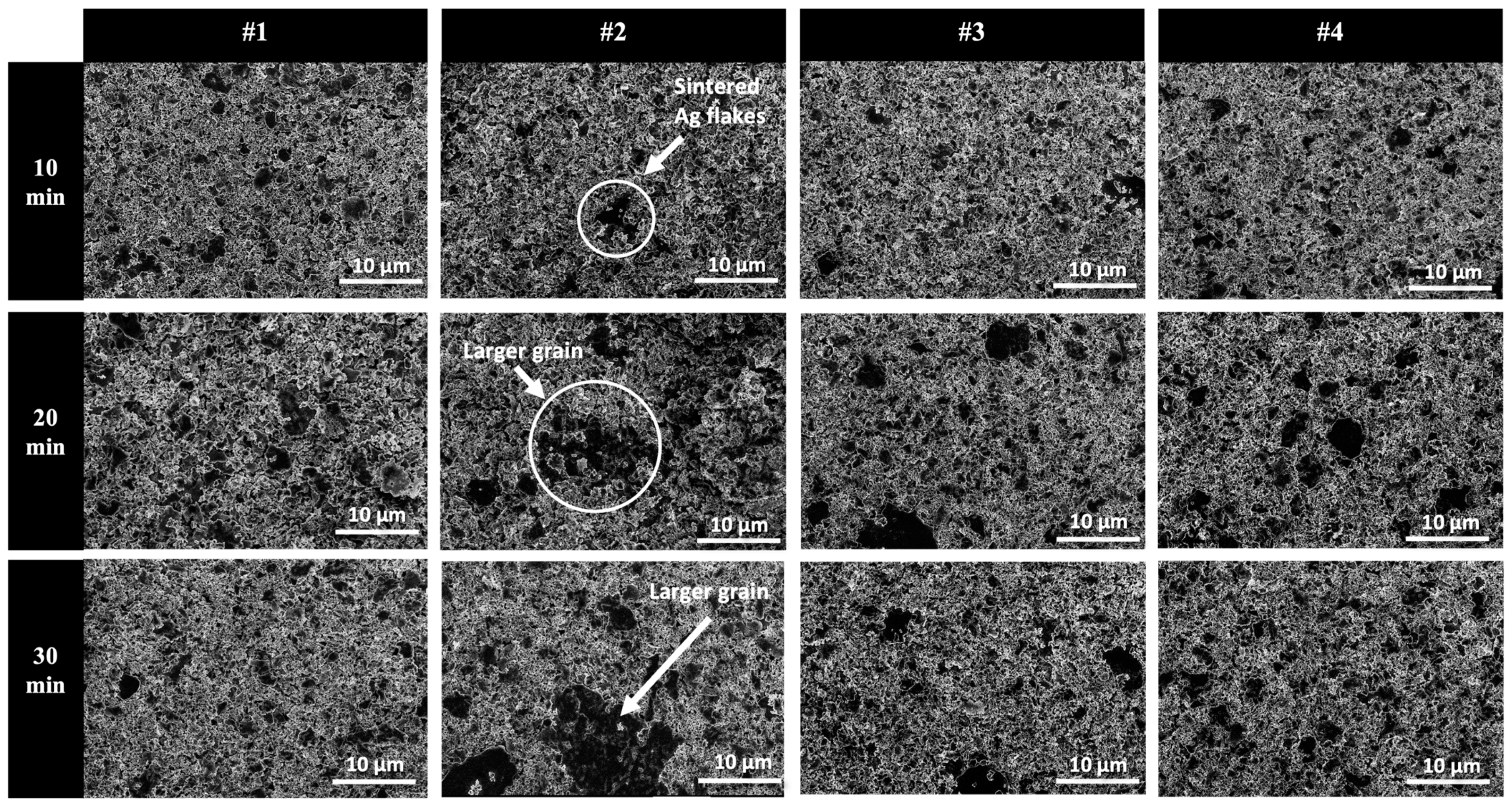

| Solvent | Molecular Formular | Chemical Structure | Molecular Weight (g/mol) | Melting Point (°C) | Boiling Point (°C) | Decomposition Temp. (°C) | Viscosity (mPa·s at 20 °C) |
|---|---|---|---|---|---|---|---|
| α-Terpineol | C₁₀H₁₈O |  | 154.25 | 31 | 210 | - | 20 |
| DPMA | C₁₀H₁₈O₃ |  | 190.23 | −23 | 216 | - | 4.5 |
| DGDE | C₆H₁₄O₄ |  | 162.23 | −64 | 190 | - | 0.95 |
| HPC | (C₆H₁₀O₅)n [(OC₃H₆OH)(OH)₃]n−3 |  | 100,000 | - | - | 130–200 | 6–10 (2% aqueous solution) |
| Solvent | Solvent 1 | Solvent 2 | HPC |
|---|---|---|---|
| #1 | a-Terpineol (50 wt%) | DPMA (50 wt%) | 0 wt% |
| #2 | a-Terpineol (49.5 wt%) | DPMA (49.5 wt%) | 1 wt% |
| #3 | a-Terpineol (49 wt%) | DPMA (49 wt%) | 2 wt% |
| #4 | a-Terpineol (48.5 wt%) | DPMA (48.5 wt%) | 3 wt% |
| #5 | a-Terpineol (50 wt%) | DGDE (50 wt%) | 0 wt% |
| #6 | a-Terpineol (49.5 wt%) | DGDE (49.5 wt%) | 1 wt% |
| #7 | a-Terpineol (49 wt%) | DGDE (49 wt%) | 2 wt% |
| #8 | a-Terpineol (48.5 wt%) | DGDE (48.5 wt%) | 3 wt% |
Disclaimer/Publisher’s Note: The statements, opinions and data contained in all publications are solely those of the individual author(s) and contributor(s) and not of MDPI and/or the editor(s). MDPI and/or the editor(s) disclaim responsibility for any injury to people or property resulting from any ideas, methods, instructions or products referred to in the content. |
© 2024 by the authors. Licensee MDPI, Basel, Switzerland. This article is an open access article distributed under the terms and conditions of the Creative Commons Attribution (CC BY) license (https://creativecommons.org/licenses/by/4.0/).
Share and Cite
Jung, S.H.; Park, J.E.; Lee, J.-H. Decreasing Electrical Resistivity of Ag Film by Low-Temperature Evaporation and Sintering through Azeotrope Application. Metals 2024, 14, 1123. https://doi.org/10.3390/met14101123
Jung SH, Park JE, Lee J-H. Decreasing Electrical Resistivity of Ag Film by Low-Temperature Evaporation and Sintering through Azeotrope Application. Metals. 2024; 14(10):1123. https://doi.org/10.3390/met14101123
Chicago/Turabian StyleJung, Sang Hoon, Jae Eun Park, and Jong-Hyun Lee. 2024. "Decreasing Electrical Resistivity of Ag Film by Low-Temperature Evaporation and Sintering through Azeotrope Application" Metals 14, no. 10: 1123. https://doi.org/10.3390/met14101123
APA StyleJung, S. H., Park, J. E., & Lee, J.-H. (2024). Decreasing Electrical Resistivity of Ag Film by Low-Temperature Evaporation and Sintering through Azeotrope Application. Metals, 14(10), 1123. https://doi.org/10.3390/met14101123







